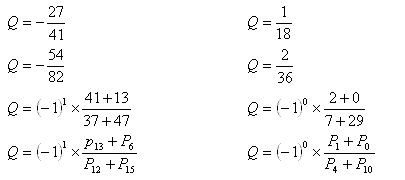Constructing rational numbers using zeroes, ones, and prime numbers
[Another mathematics intensive post. Knowledge of lower-secondary mathematics assumed]
Assuming the Goldbach Conjecture is true,

Where Q is any rational number
Z = 0, 1
PN is the N-th prime number, P0 defined as zero.
The Strong Goldbach Conjecture (as re-expressed by Euler) asserts that any even number n >4 can be expressed as a sum of 2 primes. [1] Taking advantage of this statement, if we see an odd number in the numerator or denominator, we can simultaneously multiply them by 2, thus making them both even.
As an illustration, I will reconstruct the following rational number using the procedure highlighted above:

While the Goldbach Conjecture has not been proven since its birth in June 1742, various proofs have demonstrated that the conjecture is valid for small numbers. The latest estimate of this bound is 2 x 10^17 (5th February 2005). [1]
Of course, rational numbers could be simply constructed by taking the quotients of two natural numbers and adding a ‘–’ sign if necessary. For example:

That’s a little boring isn’t it?
References:
[1] Eric W. Weisstein. "Goldbach Conjecture." From MathWorld--A Wolfram Web Resource.
Assuming the Goldbach Conjecture is true,

Where Q is any rational number
Z = 0, 1
PN is the N-th prime number, P0 defined as zero.
The Strong Goldbach Conjecture (as re-expressed by Euler) asserts that any even number n >4 can be expressed as a sum of 2 primes. [1] Taking advantage of this statement, if we see an odd number in the numerator or denominator, we can simultaneously multiply them by 2, thus making them both even.
As an illustration, I will reconstruct the following rational number using the procedure highlighted above:

While the Goldbach Conjecture has not been proven since its birth in June 1742, various proofs have demonstrated that the conjecture is valid for small numbers. The latest estimate of this bound is 2 x 10^17 (5th February 2005). [1]
Of course, rational numbers could be simply constructed by taking the quotients of two natural numbers and adding a ‘–’ sign if necessary. For example:

That’s a little boring isn’t it?
References:
[1] Eric W. Weisstein. "Goldbach Conjecture." From MathWorld--A Wolfram Web Resource.

<< Home